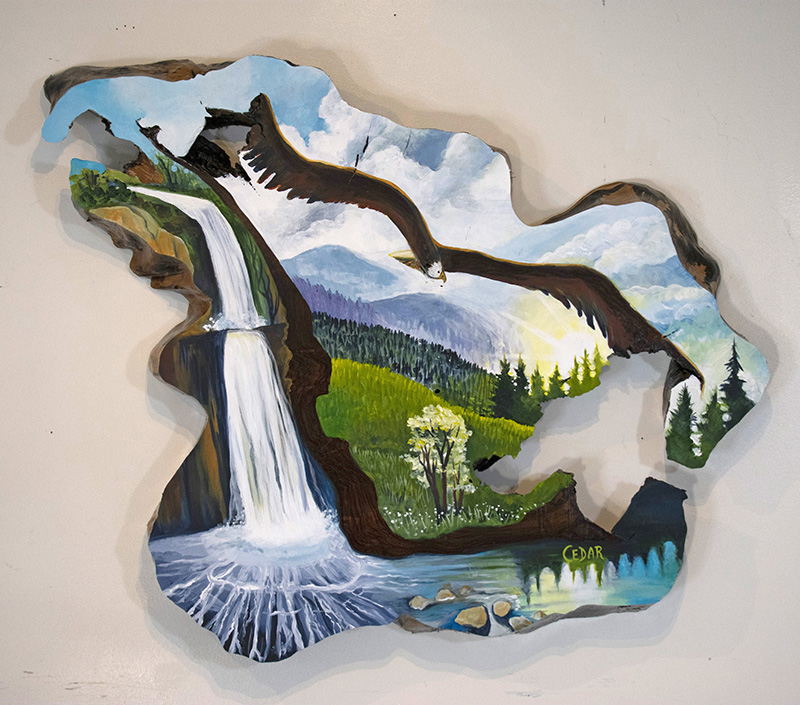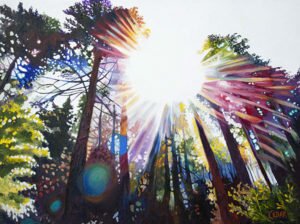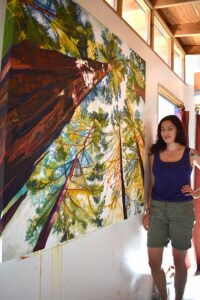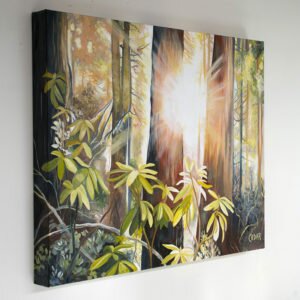For those who missed it on social media, I had an interview with Cassie Ruud of Portland’s Bridgeliner published last week!
|
|
|
Hydrologic Cycle. ~27″ x 32″, Acrylic on Live Edge Slab, © 2021 Cedar Lee (🎨: Cedar Lee) |
|
|
Today we’re exploring the wonderful weirdness of Portland’s natural beauty in art, and what that means for making our city a sustainable place with local artist Cedar Lee. For those not in the know, care to walk us through how you began to incorporate nature into your work? Nature has heavily influenced my work since the beginning, and by the beginning I mean I’ve been painting since I was a child. I sold my first painting at age 12, to one of my teachers. That was an image of a woman picking tomatoes in a field, and gardening and agriculture are kind of nature themes. If my first name isn’t a big enough clue, my parents were hippies when I was little. They had a small business growing wheat grass and sunflower and buckwheat sprouts in our backyard in Miami, FL, and distributing them to all the local health food stores there. So, from infancy, I was raised to understand and respect ecology, and to think of myself as deeply connected to the natural world. Through my teen years I mostly painted people and animals. I was thematically all over the place, as all beginning artists are, but even then, I’d always feel an urge to paint flowers, birds and insects, trees, and wild stormy skies. For my entire life, I’ve naturally gravitated towards these themes of beautiful outdoor wilderness imagery. It just makes sense to me to use these images symbolically to illustrate all my emotions and life philosophies. I’m best known for my paintings of the forest and trees. I really zeroed in on painting trees during my college years, when I attended Goucher College in Baltimore. The campus is in the middle of about 300 wooded acres. I would spend my time between classes hiking alone on the trails in those woods, and that inspired me to try and paint how that felt. Years later, having moved to the West Coast, I finally got to see the California redwoods in person. That incredible experience really made me fall in love with painting the forest all over again. How does the Pacific Northwest environment influence your work? Well, we are simply surrounded by trees here! The thing I particularly love about Portland is how many trees there are on the streets of the city, so it’s this mashup of urban and forest. We can enjoy city life here without sacrificing our connection to nature. Then as soon as you drive out of the city, it’s just glorious wilderness everywhere, rivers and mountains. Lots of blue and green. There’s a huge gardening culture here, and a hiking culture, where outdoor adventuring is a popular way to spend free time. And of course, this area is known nationwide for our environmentalist values. “Carbon footprint” is in the local lexicon. Thinking about our impact on the environment, and our relationship to it, is a big deal around here. Why is it important to celebrate the natural world — not just in art, but in our day to day experiences? Because we were not meant to be separate from it in the first place. Through the history of humanity, we have co-evolved with the environment of our planet. We don’t have to do anything special to appreciate the beauty that’s outside. Just go outside, get yourself to wherever there are some trees or some open sky, and just breathe the air and look around and notice things. I think making a point to be in nature regularly is deeply healing, not in a woo-woo way, but because getting a little fresh air, stepping away from screens, moving our bodies and being mindful enough to notice beautiful things around us literally reduces the stress in our bodies. For me personally, going for a walk outside helps calm my mind and think about my life with a bit more perspective. It doesn’t take much, even just a 30-minute walk in the woods, and it’s like a mental reset.
Sunshine Wishes. 30″ x 40″, Acrylic on Canvas, © 2019 Cedar Lee (🎨: Cedar Lee) As a Portland-based artist, is it fair to say that celebrating nature in art can be a step toward encouraging people to think about their own environmental impacts? I think so and I hope so. It’s always been my intention with my work. Climate change is on everyone’s minds right now, and I know a lot of people are thinking about what the world might look like for future generations. Storms and weather systems and droughts are becoming more and more catastrophic. Just in the past few years, it’s become clear that we now have a wildfire and smoke season here. It’s easy to start thinking about all of this and start panicking and feeling negative or upset. Then my paintings, at least for me anyway, are like this calming reminder of exactly what it is that we need and love so much and have a responsibility to protect. Without any particular political message, I think my work still reinforces that value that many of us hold dear. A lot of us are trying to do our part, whether it’s by eating more plant-based, flying less, embracing green energy, or working to elect leaders who will listen to climate scientists. And when we do those things, we do it out of love and concern for the future of our world. I do think that reinforcing a love of nature, and envisioning a positive future where our grandkids and beyond will still be able to enjoy the Earth and have wild spaces, is a more motivating force to drive our behavior than the alternative of condemnation and shaming. I can’t say for sure whether all the people who buy my paintings are environmentalists. I think nature images have broad appeal because they’re beautiful and peaceful, and I think it’s a universal shared human experience that beautiful scenery makes us feel good. That calming and healing effect we feel from actually being in a forest, a little sunshine or invigorating hopefulness—we can get a little piece of that just by looking at one of my paintings. So my hope is that when people see my paintings on the wall or online wherever, it might be a gentle and constant reminder to them of how much they love this world, and that they’re not separate from it, but a part of it. Much of my work has been me processing the immense challenge of trying to be my best self. Nature imagery has always helped me to zoom out and look at the big picture of my own life and also of all life on Earth and feeling connected to the whole universe. It’s like, “We are here. We are now. What are we gonna do with that?” Even if they aren’t thinking about it directly in that way, at the least I want my art to be spreading good vibes and coming from that place of reminding people that they love the natural world. Deep down, all humans do!
Sun-Dappled Sequoias. 48″ x 48″, Oil on Wood, © 2017 Cedar Lee (🎨: Cedar Lee) Anything exciting coming down the road for you projects-wise? Also, where can folks find you on social media, and how can they best support you directly? Yes! In the past year I’ve begun making paintings on live edge slabs. A live edge slab is a cross-section of a tree with the organic curved edges of the trunk left alone, in contrast to pieces of lumber where the edges are cut to be straight. I often leave the most beautiful features of the wood grain exposed, working the natural details of the wood into the designs of the artwork. Each one of these pieces is unique, just like the trees the slabs came from. Besides experimenting with painting on live edge slabs, I’m also working on some really large-scale pieces right now, on canvases up to six-feet across! This is so exciting to me. Each of these large-scale pieces is time-consuming and expensive to make, but I’m so invested in it, that it’s worth it to me. I’ve been doing some commissioned projects, and I’m going in the direction of working with architects and designers to create these spectacular, really dramatic huge pieces of art, and I’m working on expanding more into corporate art collections and having my art in more public spaces. And of course, as I have been doing for years now, I’m always delighted to help people choose the perfect art to transform their home or office space!
Wild Rhododendron. 24″ x 30″, Oil on Canvas, © 2020 Cedar Lee (🎨: Cedar Lee) If you’re curious to see all my past paintings going back to 2005, go to ArtByCedar.com and click on “Archives.” If you’re local and want to go see my art in person, check out: Attic Gallery in Camas: https://www.atticgallery.com/ I’m everywhere on social media, easy to find, and I appreciate every follower! Social media: Instagram: https://www.instagram.com/artbycedar/ YouTube: https://youtube.com/cedarlee Facebook: https://www.facebook.com/ArtByCedarFans/ I have a lot of affordable art prints available, to make my artwork accessible to people at every price point. In my shop at ArtByCedar.com I have art prints starting at $39. If you have any K-5-aged children in your life, I illustrated a book last year about the aurora borealis, “A Search for the Northern Lights” by Elizabeth Rusch and Izzi Rusch — the authors are also Portland-based. It’s really beautiful and makes a great gift for kids, and I’m selling illustrator-signed copies on my site. Purchasing one of those books from me is a small but meaningful way to support my work. You’ll find this book in my shop at ArtByCedar.com as well. The best way to support my work is of course to purchase an original! I’m easy to work with and good at helping people bring their visions to life. You can always email me with any questions: Cedar@ArtByCedar.com Lastly, supporting artists doesn’t always mean with money. This is 100% free to do but makes a huge difference for every working artist. Not just for me, but anytime you find a new artist whose work you love, take a moment to go follow all their social media stuff and then just spread the word! Make a point to tell your friends, “Hey, go check out this artist I found!” This goes such a long way in helping to connect me with people who are drawn to my work. Win / win! |



